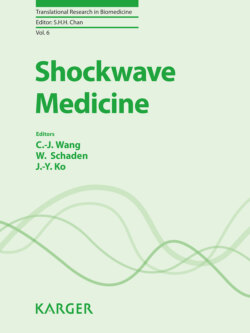Читать книгу Shockwave Medicine - Группа авторов - Страница 26
На сайте Литреса книга снята с продажи.
Dosage Does Matter and Challenges in Future
ОглавлениеPresently, there are limited data describing the dose effect of shockwave on the biomechanical properties of ONFH. Previous studies demonstrated a dose-related effect of ESWT in musculoskeletal disorder [27–29]. Kong et al. [14] investigated the application value of extracorporeal shockwave shock to repair and reconstruct osseous tissue for the treatment of ONFH by using energy density of ESWT from 0.18 to 0.25 mJ/mm2 in 36 patients with 42 hips. They found that ESWT had obvious therapeutic effects in the repairing and reconstructing osseous tissue and the hip Harris score and hip function had improved. Kusz et al. [15] assessed 9 patients with ONFH, ARCO stage I to III, treated by shockwave therapy with a dose of 1,500 pulses at an EFD of 0.4 mJ/mm2 and a frequency of 4 Hz at each point, which each patient receiving 4 points in the femoral head and 5 therapy sessions. After 6 weeks follow-up, the patients demonstrated pain reduction and improved mobility of the treated joint with considerable improvement in quality of life. The effectiveness of ESWT was to reduce pain and slow down the progression of bone damage in 36 patients with unilateral ONFH of ACRO stage I to III. Each treatment included four sessions, with 2,400 impulses each administered at 0.50 mJ/mm2 at 48–72 h intervals. Patients in ARCO stages I and II groups achieved significantly better results than those in the ARCO stage III group. ARCO stages I and II lesions were unchanged on radiographs and magnetic resonance images. Their results showed that ESWT in ARCO stages I and II may help to prevent progression of the area with avascular necrosis and manage pain [11].
The shockwave therapy with 6,000 impulses at 28 kV (0.62 mJ/mm2) in a single session was used to treat 35 patients (47 hips) with ONFH [30]. Data showed that the local ESWT application resulted in significant systemic elevations of serum nitric oxide level, angiogenesis (vascular endothelial growth factor, VEGF; Von Willebrand factor, vWF; and fibroblast growth factor-basic) a decrease of transforming growth factor beta (TGF-β1), an increase of osteogenic markers (bone morphogenetic protein 2, BMP-2; osteocalcin, alkaline phosphatase and insulin-like growth factor), and a decrease of Dickkopf-related protein 1 (DKK1) and anti-inflammatory factors (soluble intercellular adhesion molecule and soluble vascular cell adhesion molecule, sVCAM) at 1 month after ESWT. In another study, they found the application of shockwave results in regeneration effects in 7 hips with ONFH with significantly more viable bone and less necrotic bone, higher cell concentration cell activity including phagocytosis and increases in vWF, VEGF, and CD 31 and Winless 3a and proliferating cell nuclear antigen, and decreases in VCAM and DKK1 [31]. When patients with SLE were affected by ONFH, ESWT also demonstrated its effectiveness with improvement in hip pain and function and image changes on X-ray and MRI in 15 SLE patients with 26 hips [32]. Besides the above, the effects of different dosages of ESWT were reported in early ONFH [19]. High-dose ESWT (6,000 impulses at 24 Kv [0.510 mJ/mm2]) is more effective than low-dose energy (2,000 impulses at 24 Kv) in systemic beneficial effects such as enhancement of angiogenesis with improvement of microcirculation of the peri-necrotic areas. In turn, high-dose ESWT can improve subchondral bone remolding and prevent femoral head collapse more effectively than low-dose therapy in early ONFH. However, in 2016, Han et al. [33] reported lower energy density ESWT in the treatment of early stage of ONFH with 6-month follow-up. They showed ESWT indeed has a significant effect in treating the symptoms of ONFH, but there was no significant difference between the two groups (1,000 shocks/session, EFD per shock 0.12 and 0.32 mJ/mm2, 4 sessions), regardless of the difference in EFD.
To summarize the results of previous researches, there is still no standard protocol of ESWT for clinical application in ONFH. Part of the reasons is due to the fact that the success rate of treatment in ONFH is more dependent on the stage of this disease. Many experimental and clinical researches tried to preserve the hip joint and prevent the progression to the secondary degenerative change during the early stage of ONFH. In order to set a standard procedure of shockwave therapy, the International Society for Medical Shockwave Treatment recommends a protocol, 0.62 mJ/mm2 of EFD in 4,000 impulses delivered to the skin close to the damaged bone for ONFH treatment. Further studies are necessary to assess the optimal timing and dosage of ESWT on ONFH in the future.
In conclusion, ESWT is a new technology and has the potential of replacing surgery in ONFH without the surgical risks. In clinical trials and animal experiments, ESWT stimulates a cascade of signal transduction responses and a series of protein changes to exert its effectiveness in the management of ONFH through neovascularization and regeneration of the bone. Studies to date, however, have involved small numbers with short-term and long-term follow up. A protocol is needed to standardize the optimal timing and dosage of ESWT on ONFH. Further studies are necessary to assess this option in the future.
